
Norway - former state railways NSB, now Vy, multiple units
For a full scale picture, please click on the picture shown !
Commuter and regional electric multiple units under the new name and colours of Vy
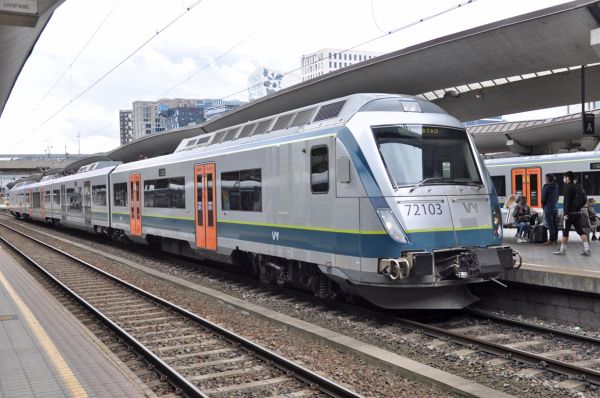
Passenger traffic is today only partially in the hands of the previous state monopoly, Norske Statsbaner NSB
which is now called Vy. Vy runs mainly regional trains around Oslo. In the middle and southern parts of the country,
where most lines are electrified, most of the passenger trains consist of electric multiple units, whereas in the very north
diesel multiple units and diesel locomotive driven train sets still persist. Around Oslo the key operator is still Vy, whereas
in almost all other parts of the country the Swedish SJ has taken over.
This is a class BM72 regional train operating around Oslo. If you compare this picture with the ones taken during the times when
state railways was still NSB, you can notice that nothing else is new, except stickers at the sides and on the front, now promoting
the new name Vy. See below and compare.
Picture from Oslo sentral 3.7.2022 by Marek Graff.
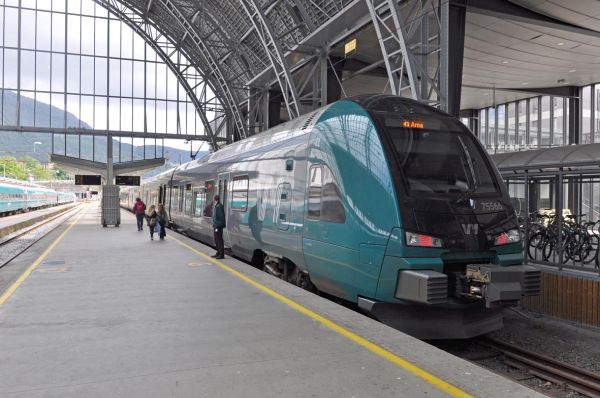
A FLIRT train of the subclass BM75 which has received a new green and grey Vy painting instead of its former red and grey one.
Picture from Bergen 4.7.2022 by Marek Graff.
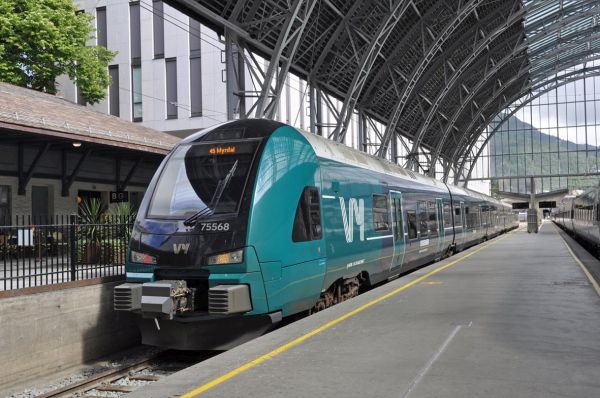
Another picture of a class BM75 FLIRT in new Vy paintings.
Picture from Bergen 4.7.2022 by Marek Graff.
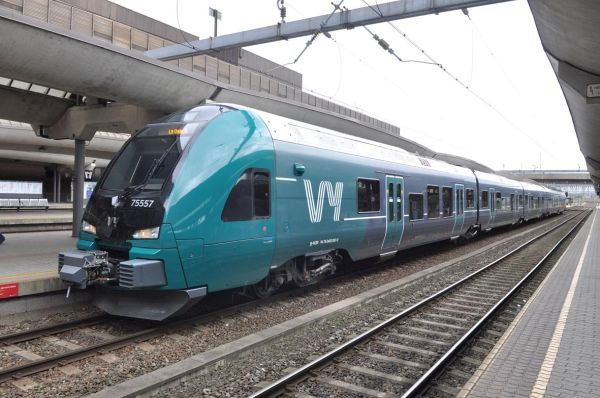
Still another view of a Vy BM75 FLIRT. The new painting looks rather good.
Picture from Oslo sentral 3.7.2022 by Marek Graff.
Commuter and regional electric multiple units still in the colours of NSB
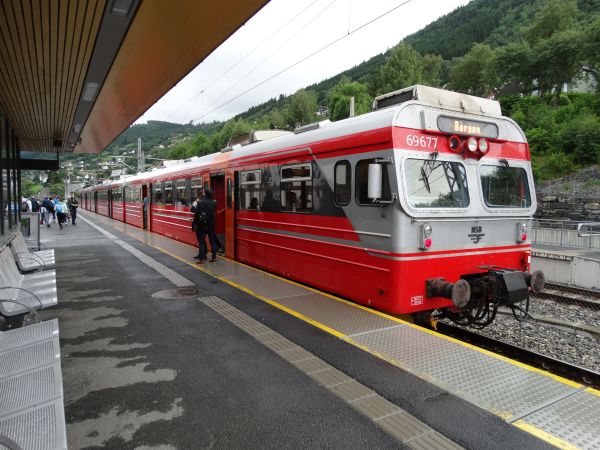
Our first picture shows this very old but renovated class 69 unit pushed aside from the capital city to perform sideline duty between
Bergen and Voss. This is history now and these oldies have been replaced by modern Stadler FLIRT trains already some years ago.
Picture of an old NSB class 69 at Voss station 2.7.2016 by Ilkka Siissalo.
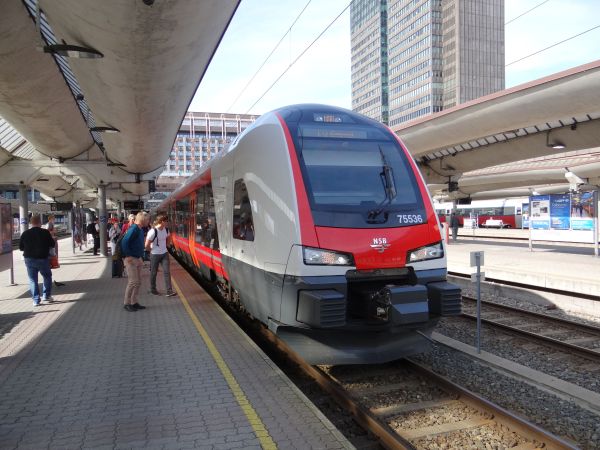
This is a Swiss Stadler built 3rd generation FLIRT train of the NSB class 75. NSB ordered well over 100 FLIRT trains both in short distance
as well as long distance express train varieties. They were partly given to the new winner of the public tendering, so only a small number
remain with Vy. Class 75 is one of the newest varieties, it is a local commuter train intended especially for the fairly short distance
city traffic around Oslo. Top speed is 200 km/h. Class 74 is the FLIRT variant for longer distances, but still "regional". Also dual power
electric/diesel varieties have been ordered for use in the very north, where all main lines are not yet electrified. Here we see this FLIRT
still in the old NSB painting scheme.
Photo from Oslo sentral station 10.9.2015 by Ilkka Siissalo.
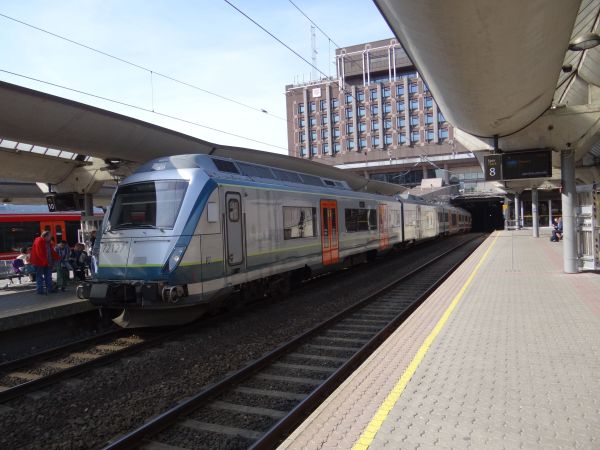
NSB class 72 used to be Norway's newest and finest EMU trains before the FLIRTs arrived. They were built by AnsaldoBreda 2002-2005
in 35 copies. An option to buy more was never exercised and as with many other cases, AnsaldoBreda's quality was not satisfying the
customer, although for passengers the trains are very nice and comfortable. Top speed is 160 km/h.
Photo from Oslo sentral station 10.9.2015 by Ilkka Siissalo
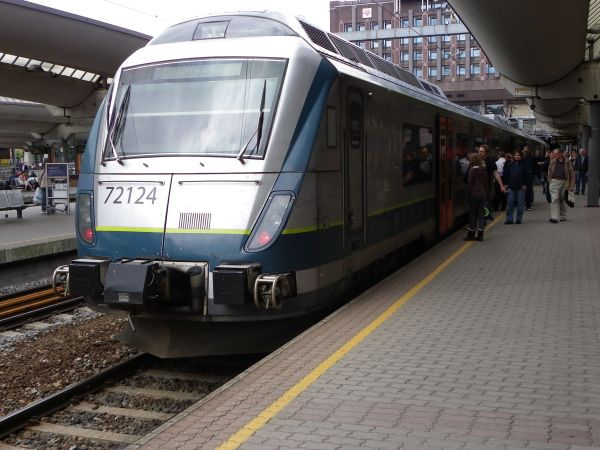
Another AnsaldoBreda built class 72 unit at Oslo sentral still in the times of NSB. These trains are very nice inside, with stylish
wooden walls, very comfortable seats and style that comes close to luxury. But just like Italian cars, these Italian
trains are nice to drive, but are full of faults and suffer from corrosion.
Picture from Oslo sentral 21.6.2011 by Ilkka Siissalo.
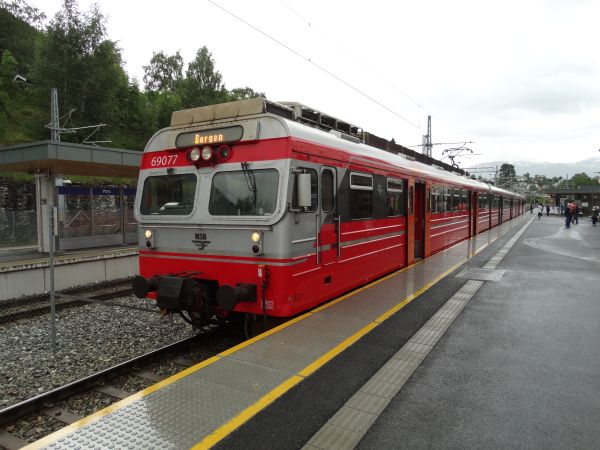
Still a couple of years ago almost all regional traffic around Oslo was run by these electric multiple
units of the class 69. They were built in 4 different series since 1971 and after refurbishments NSB
classed them into 6 subclasses BM69A to BM69G. This one was one of the BM69E series (refurbished D-series
modified with a bit better seats for longer distances) which can easily be recognised by the different looking ("diver's mask")
front windows of the drivers' cabs. These trains were first almost completely pushed out of traffic and replaced by new Stadler
FLIRT trains in the Oslo region and the old 69s were given duties on sidelines further away from the capital. Now they are pushed out
from even there, so this is history now.
Photo from Voss 2.7.2016 by Ilkka Siissalo.
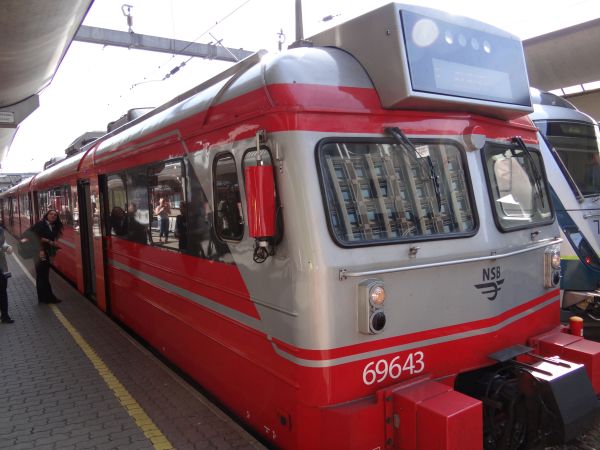
This was the other subtype, a class BM69C train after refurbishments.
Photo from Oslo sentral station 10.9.2015 by Ilkka Siissalo
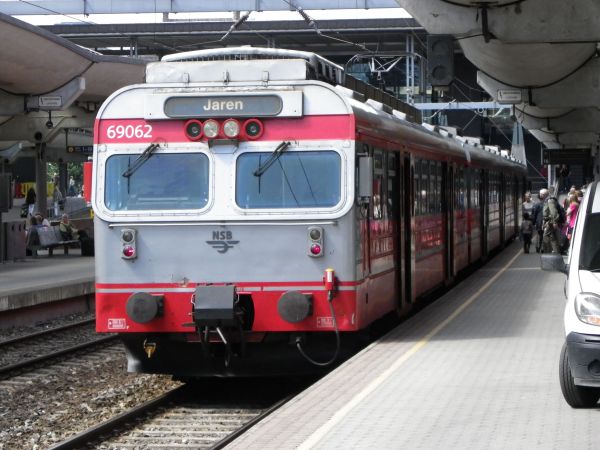
This was a class 69 subtype BM69D unit, repainted/refurbished, but with no major renovations. For example an
airconditioner for the driver's cab on the roof does not exist like in the later refurbished units.
Subtype D was built 1983-84. They had already the newer "diver's mask" style front windows, but inside
their main difference with the older versions was just better seats.
Picture from Oslo sentral 21.6.2011 by Ilkka Siissalo.
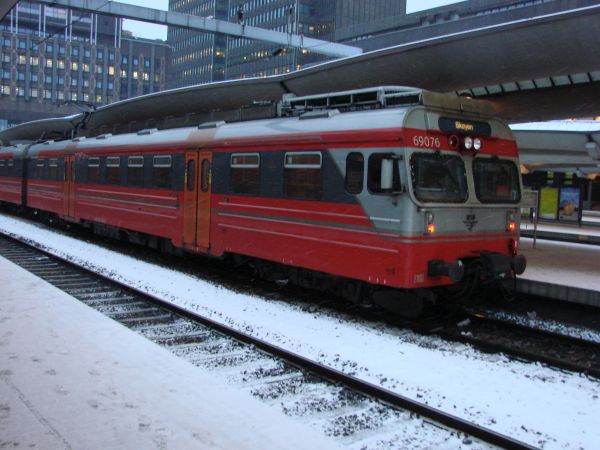
A similar BM69D train like the one shown above.
Picture from Oslo sentral 18.1.2009 by Ilkka Siissalo.
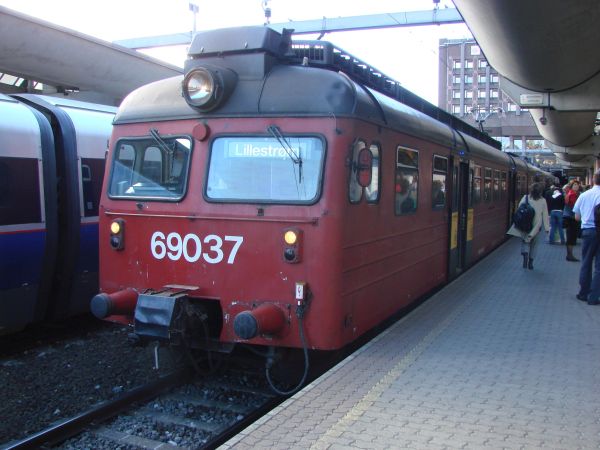
This is what the class 69 trains looked like before renovation, in the so called "in-between" painting.
A class BM69C unit at Oslo sentral station 14.9.2007. Photo by Ilkka Siissalo.
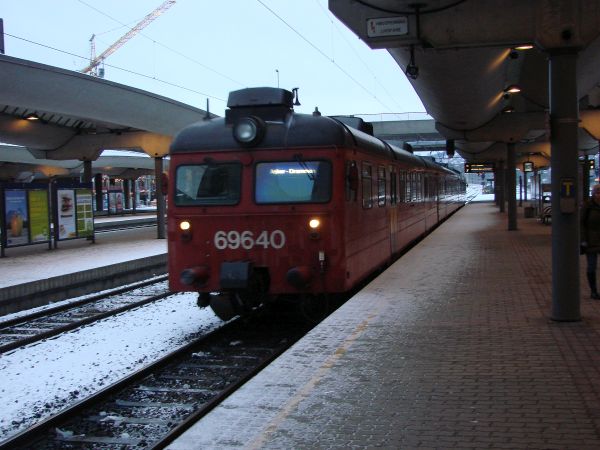
Another old class BM69C train before refurbishing, here stopping at the Oslo sentral before continuing to Drammen.
Picture from Oslo sentral station 18.01.2009 by Ilkka Siissalo.
Long distance electric multiple units in the old colours of NSB
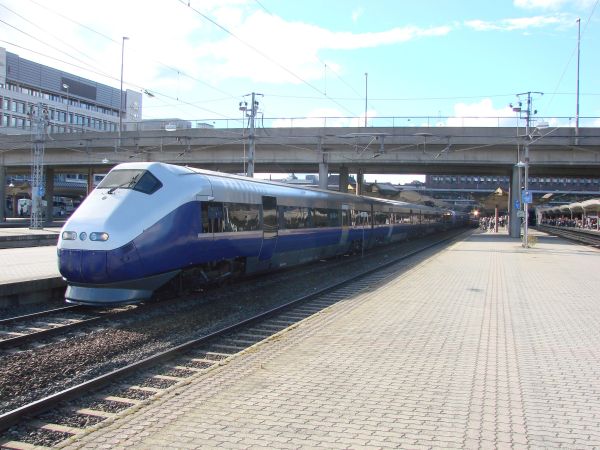
Two class BM73 long distance electric multiple units forming an express train from Oslo to Trondheim in the old NSB times.
This was the original livery. These trains were Norway's first tilting fast trains. They were built by Kalmar Verkstad in
Sweden and the design is based on the Swedish X2000 train.
Photo taken at Oslo sentral 14.9.2007 by Ilkka Siissalo.
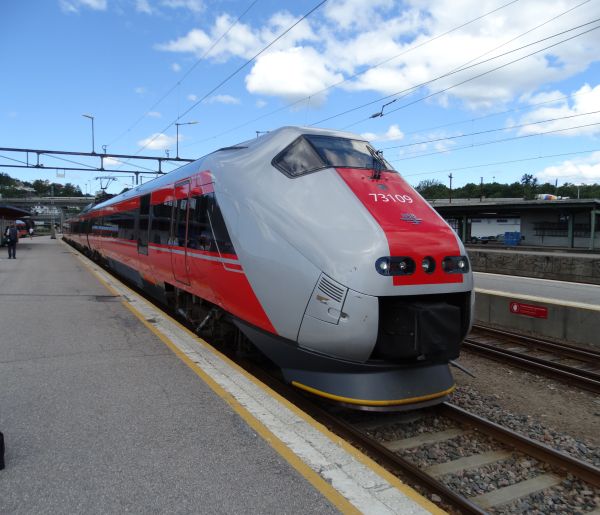
This is what the same class BM73 tilting bullet trains looked like in the latest NSB colourings after their refurbishment, but still
before the times when NSB became Vy. In the photo a BM73 is just arriving from Stavanger to the station of Kristiansand to then
continue as an express service to Oslo.
Photo from Kristiansand 6.7.2016 by Ilkka Siissalo.
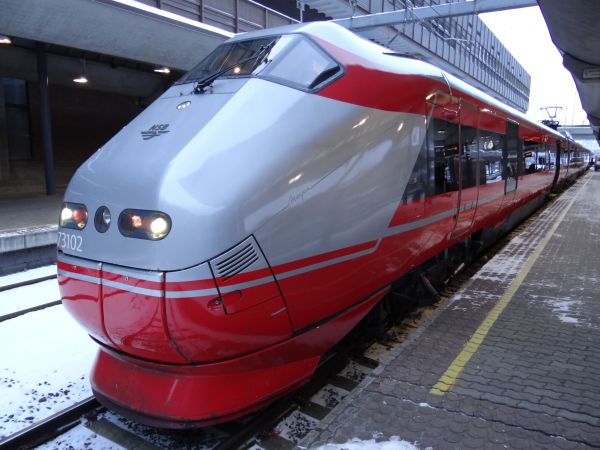
Another BM73 in NSB's colours. The paintings differ slightly depending on when the train was refurbished. There were actually quite
many variations of the grey and red theme.
Picture taken at Oslo S 19.1.2014 by Ilkka Siissalo.
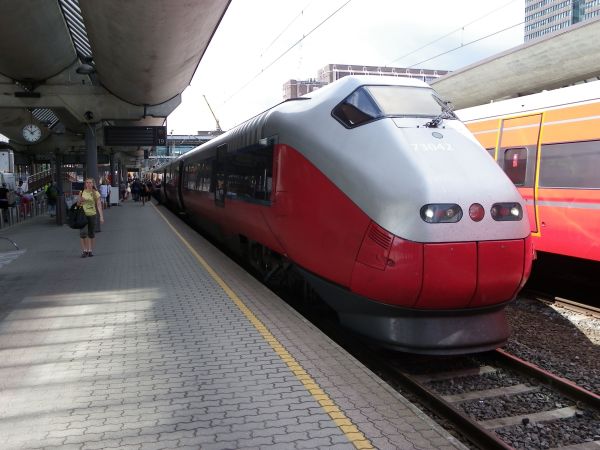
This is also a class 73 tilting train, but of the subtype BM73B. After renovation they were painted red and grey like this.
This is the subtype B which has been used on the Oslo-Göteborg(SWE) route and on the Oslo-Halden route in the same direction,
so called Østfoldbanen. Subtype 73B is intended for shorter express train routes and has no cafeteria/bistro and no special space for
care of small children as the "real" BM73 does. After their renovation the B-type could easily be recognised from the longer
distance type - see the picture above and compare the paintings with this one.
Picture taken at Oslo sentral 21.6.2011 by Ilkka Siissalo.
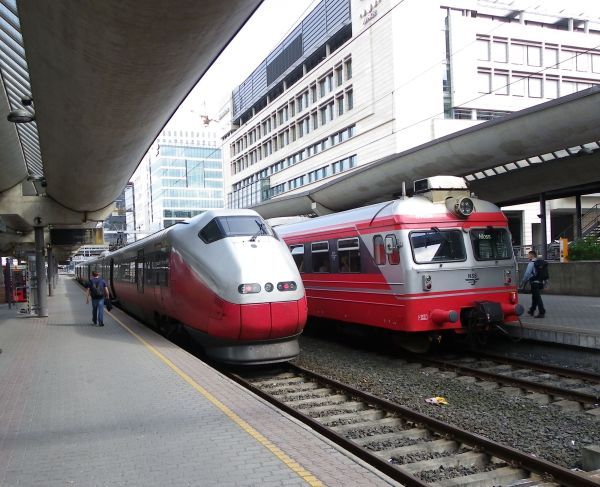
Something newer and something older meeting in Oslo. A class BM73B EMU on the left and an old, just slightly
modernised regional train of the class 69 subtype 69C. The lump on the ceiling is a cooling machine to keep
the drivers from frying, but passengers had to suffer still.
Picture from Oslo sentral 22.6.2011 by Ilkka Siissalo.
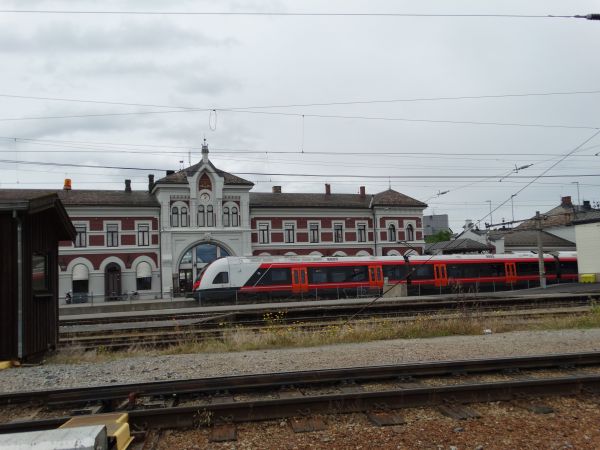
This was a class 74 "regional" Stadler FLIRT train in front of the very impressive old station building of Hamar.
Class 74 looks very much like the class 75 shown above, but it is intended for a bit longer runs and not just
capital city commuter traffic.
Photo taken in Hamar 1.7.2016 by Ilkka Siissalo.
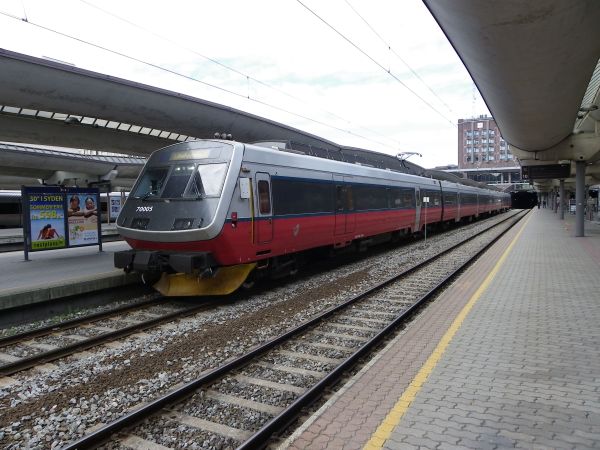
This was the class 70 regional EMU that the new class 74 FLIRTs pushed aside. They were made 1992-96
in only 16 copies by a consortium including the German company Düwag and ADtranz. They were four cars long and had
a maximum speed of 160 km/h.
Photo taken at Oslo sentral 21.6.2011 by Ilkka Siissalo.
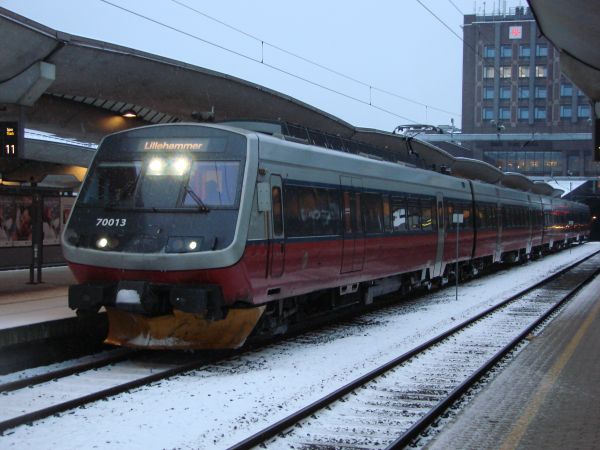
A similar class 70 electric multiple unit stopping at Oslo sentral on its way to Lillehammer.
Picture from Oslo sentral 18.1.2009 by Ilkka Siissalo.
Diesel multiple units still in the old NSB colours
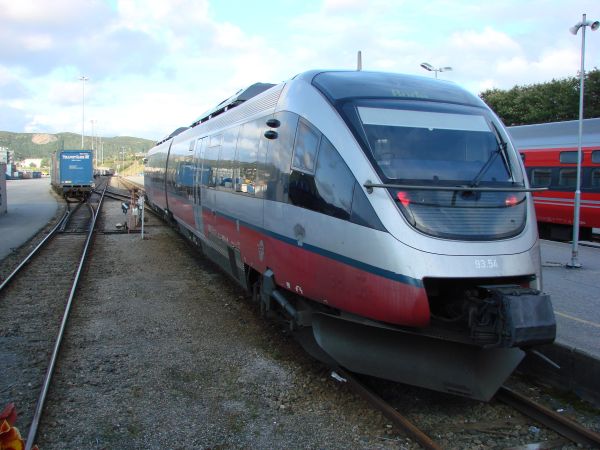
This is a class 93 railbus of the Bombardier type Talent, very similar to the Talents used in Germany, but with only two
coaches. In Norway trains also need massive snow ploughs in contrast to Germany.
Photo taken 18.8.2009 in Bodø by Ilkka Siissalo.
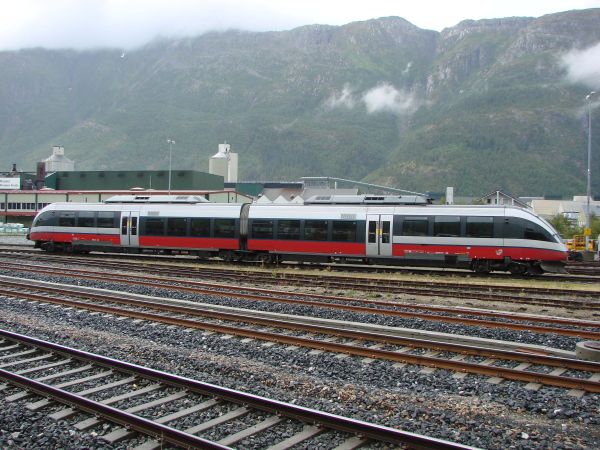
Another Bombardier Talent railbus, in Norway known as the class 93.
Picture from Mo i Rana 20.8.2009 by Ilkka Siissalo.
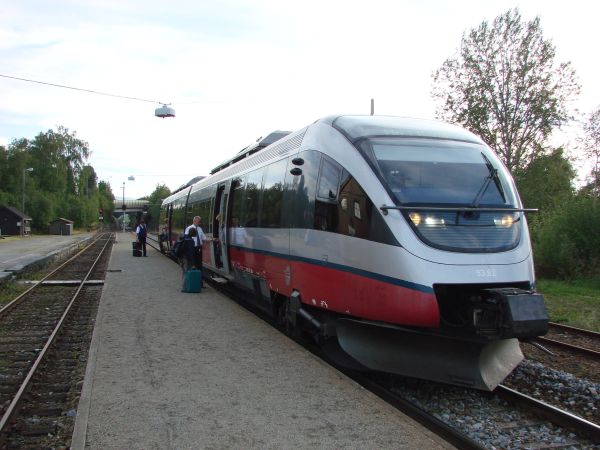
A class 93 Talent railbus is stopping at the little station of Snåsa to let out two passengers and pick up one
on the Nordlandsbanan route from Bodø to Mo i Rana.
Picture 20.8.2009 by Ilkka Siissalo.
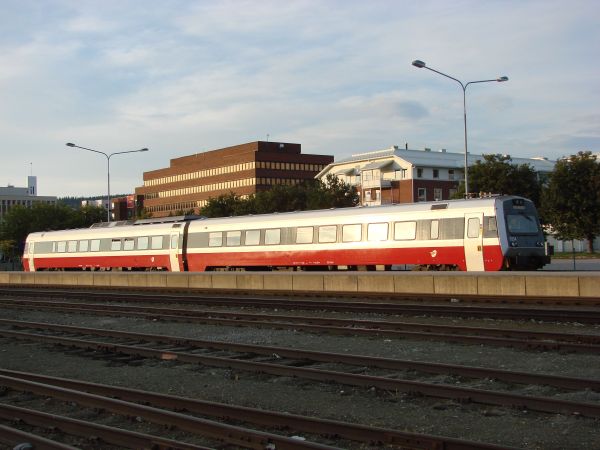
An older class 92 railbus. These trains were built by Düwag in Germany 1984-85 and NSB ordered 15 of them.
Photo from Steinkjer 20.8.2009 by Ilkka Siissalo.
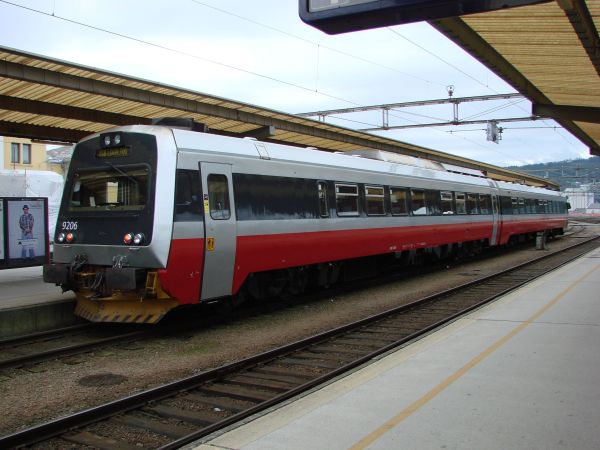
Another view of a class 92 railbus. These were further developments of the German class 628 and the Dutch
trains known as "Wadlopers", also made by Düwag. Compare with the class 70 electric units shown above
on this same page. They came out of the same factory.
Photo taken in Trondheim 21.8.2009 by Ilkka Siissalo.
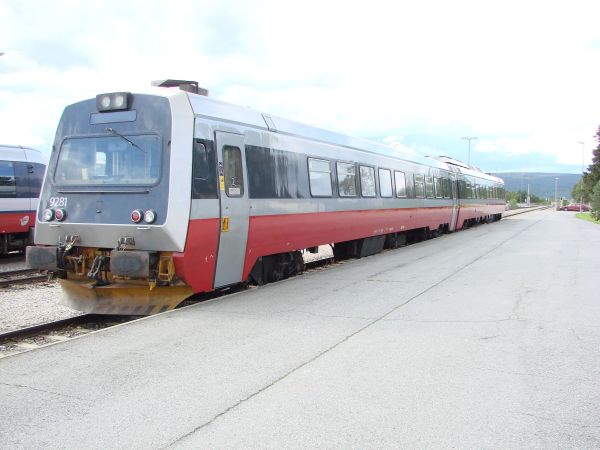
Still another view of a class 92 Düwag.
Picture from Röros station 22.8.2009 by Ilkka Siissalo.
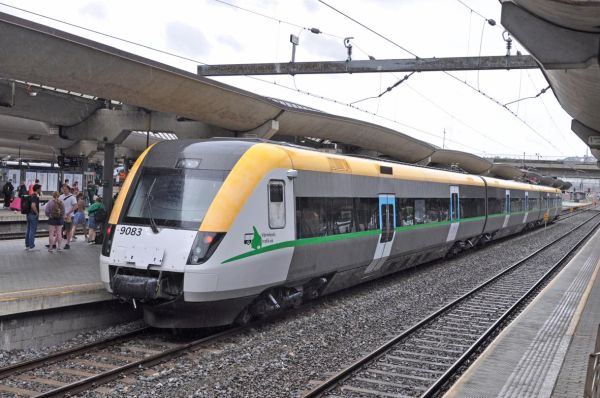
The train looks odd and foreign to be in Norway as it is a Värmlandstrafiken's Alstom Regina, but nevertheless, this is a service
operated by the present day Vy, former Norwegian state railways. Vy runs now after the corona epidemic again cross border services
at least from Örebro, Karlstad and Charlottenburg on the Swedish side of the border directly to Oslo. Vy offers also tickets to
ride between Oslo and Stockholm, but as far as we know (July 2022) these are bus and not train connections.
Picture from Oslo sentral 3.7.2022 by Marek Graff.
Airport train Flytoget
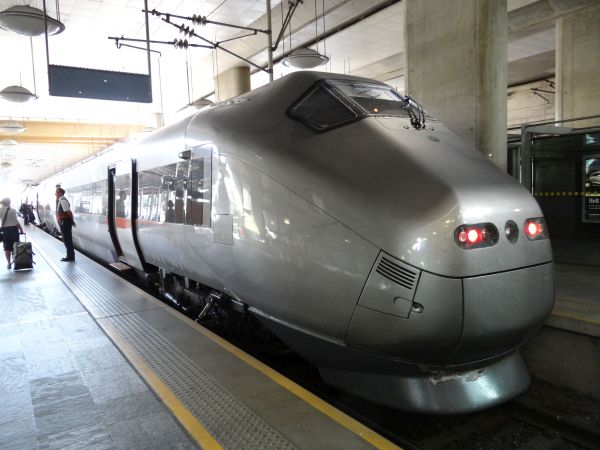
This is a "Flytoget" airport train of the class BM71. It is a modified version of the long distance class BM73
tilting train connecting the Oslo-Gardermoen airport to the Oslo metropolitan area. Top speed is 210 km/h.
Photo at Gardermoen 8.9.2015 by Ilkka Siissalo.
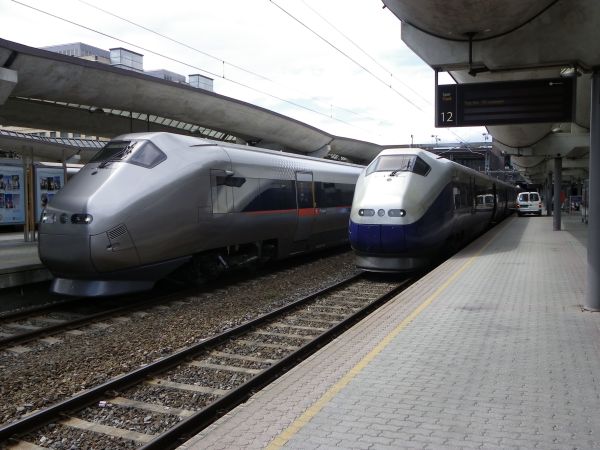
Like sister and brother, but whereas the BM71 Flytoget train on the left is intended just for a 19 minutes dash
to the airport, the BM73 on the right (in older grey and blue livery) is used on really long lines with 5 to 6 hr duration to
Trondheim, Stavanger or Bergen and has all the comforts like for example a bistro wagon. Note that instead of
backwards looking mirrors, the drivers of both trains have backwards looking video cameras in the small "ears"
by the sides.
Picture from Oslo sentral 21.6.2011 by Ilkka Siissalo.
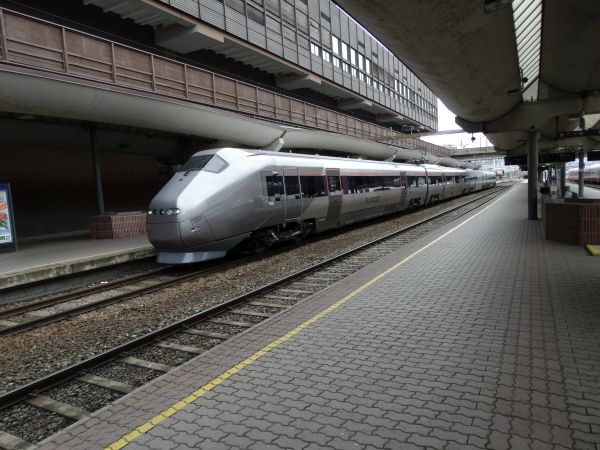
A Flytoget class 71 train after a total refurbishment and after receiving an additional coach.
Picture from Oslo S 11.5.2017 by Ilkka Siissalo.
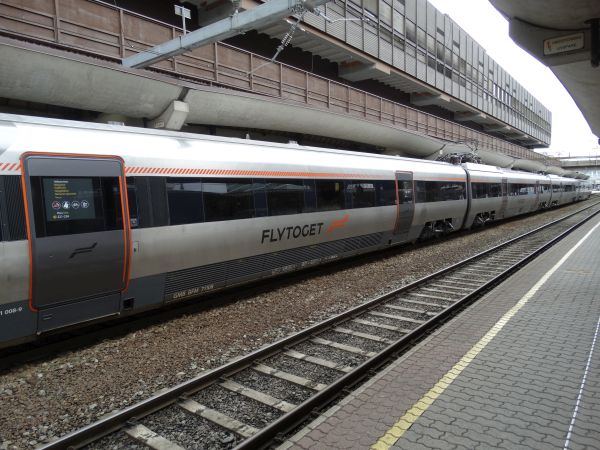
A closeup picture showing the side of the same refurbished Flytoget train as above. The main reason for the renovation of these trains
was to increase capacity by adding more coaches.
Picture from Oslo S 11.5.2017 by Ilkka Siissalo.
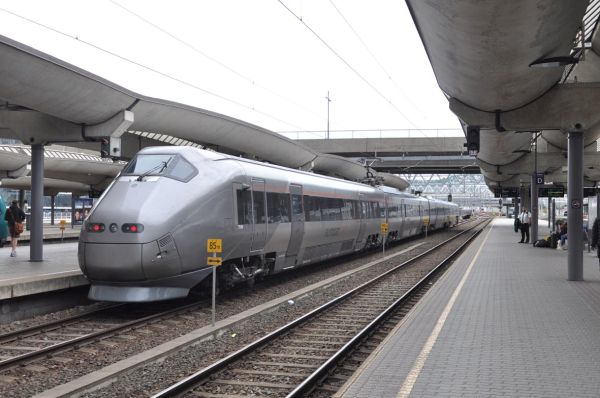
Another refurbished Flytoget train of the class BM73B.
Picture from Oslo sentral 3.7.2022 by Marek Graff.

